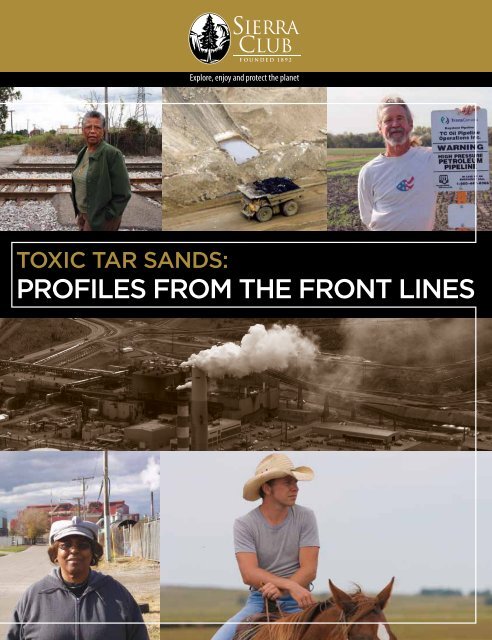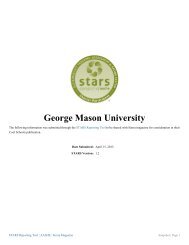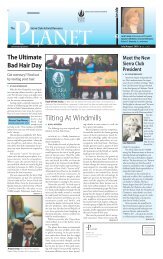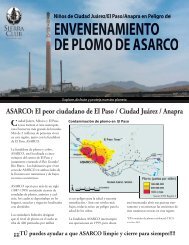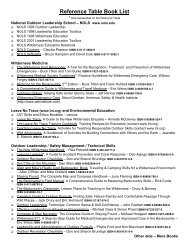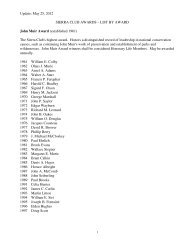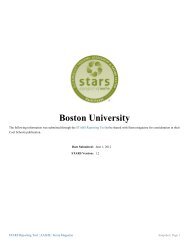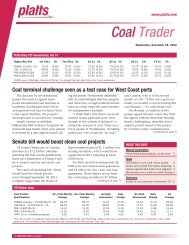Toxic Tar Sands: Profiles from the Front Lines - Sierra Club
Toxic Tar Sands: Profiles from the Front Lines - Sierra Club
Toxic Tar Sands: Profiles from the Front Lines - Sierra Club
Create successful ePaper yourself
Turn your PDF publications into a flip-book with our unique Google optimized e-Paper software.
Explore, enjoy and protect <strong>the</strong> planet<br />
TOXIC TAR SANDS:<br />
PROFILES FROM THE FRONT LINES
oxic<br />
ar Sand<br />
Most AMericAns have never heard of<br />
<strong>the</strong> Alberta tar sands, yet it is one of <strong>the</strong> largest<br />
and most destructive projects on Earth. This<br />
little-known industrial mega-project is creating an<br />
ongoing environmental disaster in Canada, and is now<br />
threatening to create one here in <strong>the</strong> United States.<br />
<strong>Tar</strong> sands oil is mined <strong>from</strong> a black sticky substance<br />
called bitumen, found beneath <strong>the</strong> vast boreal forest<br />
in Alberta, Canada. To extract tar sands crude, oil<br />
companies clear-cut ancient forest, <strong>the</strong>n strip mine <strong>the</strong><br />
soil beneath it, using huge quantities of fresh water<br />
2 TOXIC TAR SANDS: PROFILES FROM THE FRONT LINES<br />
and natural gas to separate <strong>the</strong> oil <strong>from</strong> bitumen. The<br />
process leaves behind giant toxic lakes that are linked<br />
to abnormally high rates of cancer in neighboring<br />
communities and are large enough to be seen <strong>from</strong> space.<br />
But it doesn’t stop <strong>the</strong>re. The oil industry is expanding<br />
facilities to process this toxic oil here in <strong>the</strong> United States<br />
through a network of refineries and pipelines. Public health<br />
in several states is under threat <strong>from</strong> dramatic increases in<br />
refining pollution, and massive pipelines are planned to<br />
cross <strong>the</strong> United States’ largest freshwater aquifer, which<br />
supplies one-third of our nation’s agriculture.
S Oil<br />
Communities in Alberta have long been speaking<br />
out about <strong>the</strong> damage tar sands poses to <strong>the</strong>ir health<br />
through water and air pollution. Now, Americans <strong>from</strong><br />
Minnesota to Houston are worried about Canada’s tar<br />
sands expansion poisoning <strong>the</strong>ir water, destroying <strong>the</strong>ir<br />
farmland, and contaminating <strong>the</strong>ir air.<br />
Here, we profile thirteen people <strong>from</strong> across North<br />
America whose health and livelihoods are at risk as a<br />
result of toxic tar sands expansion.<br />
PHoTo: DAvID DoDGE, PEMBINA INsTITuTE<br />
<strong>Tar</strong> SandS Oil POiSOnS Our air<br />
Processing tar sands oil releases pollutants directly linked<br />
to asthma, emphysema and birth defects into American<br />
communities. Because tar sands oil is a heavy, low-quality form<br />
of crude, it requires extensive “upgrading” to be transformed into<br />
fuel. Refining tar sands crude creates far more air pollution in<br />
American communities that are already burdened with cancer<br />
and poor air quality as a result of oil industry activities. <strong>Tar</strong> sands<br />
oil contains, among o<strong>the</strong>r toxic metals, 11 times more sulfur and<br />
nickel, six times more nitrogen, and five times more lead than<br />
conventional crude oil. 1<br />
Heavy metals and polycyclic aromatic hydrocarbons released<br />
in tar sands refining have been linked to pre-natal brain damage.<br />
Nitrogen oxides, along with volatile organic compounds released<br />
in tar sands refining are <strong>the</strong> principal causes of smog and groundlevel<br />
ozone. Exposure to nitrogen oxides is a direct cause of<br />
asthma, emphysema and o<strong>the</strong>r lung diseases.<br />
With plans to triple refining and transportation of tar sands by<br />
2015, <strong>the</strong>re is no question that air pollution and health problems<br />
in communities <strong>from</strong> <strong>the</strong> Great Lakes to <strong>the</strong> Gulf Coast will<br />
increase.<br />
<strong>Tar</strong> SandS Oil COnTaminaTeS<br />
Our Clean WaTer<br />
<strong>Tar</strong> sands production wastes and contaminates tremendous<br />
amounts of water. Every barrel of oil produced requires four<br />
barrels of water. In this process, water is pumped into toxic waste<br />
reservoirs large enough to be seen <strong>from</strong> space. The mercury, lead<br />
and arsenic in tar sands waste threaten human health, even at<br />
small levels of exposure. Already, communities downstream <strong>from</strong><br />
tar sands mines in Canada report 30 percent more incidents of rare<br />
bile duct cancer than those who do not live near <strong>the</strong> tar sands. 2<br />
Expanded reliance on this dirty oil would put important<br />
American water sources at risk. Canadian pipeline companies<br />
currently operate 1,900 miles of oil pipelines in and around <strong>the</strong><br />
Great Lakes watershed, which supplies 25 million people with<br />
drinking water.<br />
<strong>Tar</strong> sands oil contains elevated levels of many known carcinogens<br />
and toxins. In a recent study, tar sands wastewater “tailings” <strong>from</strong><br />
extracting oil were found to contain ammonia, benzene, cyanide,<br />
phenols, toluene, polycyclic aromatic hydrocarbons, arsenic,<br />
copper, sulphate, and chloride. 3 Many of <strong>the</strong>se chemicals are<br />
highly toxic and known to cause cancer, and regularly leach into<br />
groundwater <strong>from</strong> <strong>the</strong> massive lakes used to store tailings. 4 These<br />
chemicals are present in tar sands oil before and after processing,<br />
and will end up in American groundwater when pipelines leak.
THE HEART OF THE TAR SANDS:<br />
A BligHt on nAtiVe coMMUnities<br />
people Are dying,” says George Poitras, a<br />
“My member of <strong>the</strong> Mikisew Cree First Nation in Fort<br />
Chipewyan, Alberta. His community, situated just downstream<br />
<strong>from</strong> <strong>the</strong> vast toxic moonscape of tar sands development in Alberta,<br />
has absorbed some of <strong>the</strong> worst damage <strong>from</strong> <strong>the</strong> project.<br />
“The extraction of oil <strong>from</strong> Canada’s tar sands is having a<br />
devastating impact on our indigenous people,” Poitras says.<br />
Studies have found levels of mercury, arsenic, lead, and o<strong>the</strong>r<br />
toxins at elevated levels near <strong>the</strong> area’s tar sands excavation sites. 5<br />
These chemicals are known carcinogens and cause <strong>the</strong> types of rare<br />
cancers—including cancer of <strong>the</strong> bile ducts—that are on <strong>the</strong> rise<br />
among members of <strong>the</strong> Fort Chipewyan community.<br />
Statistically, bile duct cancer normally occurs in one out of<br />
every 100,000 people. But a study by <strong>the</strong> Alberta Cancer Board<br />
confirmed <strong>the</strong>se cancer rates at Fort Chipewyan are 30 percent<br />
higher than average. 6<br />
Poitras has been on a mission to raise awareness about <strong>the</strong> harmful<br />
effects of tar sands development on his community’s health—ever<br />
since 2006, when Fort Chipewyan’s general physician, Dr. John<br />
O’Connor, went public in <strong>the</strong> press about <strong>the</strong> unusual cancers<br />
among <strong>the</strong> patients he served.<br />
4 TOXIC TAR SANDS: PROFILES FROM THE FRONT LINES<br />
<strong>Tar</strong> SandS are deSTruCTive aT every STage Of Their lifeCyCle, <strong>from</strong> <strong>the</strong><br />
ravaged boreal forests of Nor<strong>the</strong>rn Canada to <strong>the</strong> choked communities in refining<br />
corridors across America. But <strong>the</strong> indigenous communities living closest to <strong>the</strong> land<br />
bear special witness to its destruction. Tribes have spoken out on <strong>the</strong> toll tar sands<br />
have taken on <strong>the</strong>ir ancestral lands and <strong>the</strong> water and wildlife that supports <strong>the</strong>ir<br />
culture and community. These are <strong>the</strong> stories of prominent tribal activists and <strong>the</strong>ir<br />
struggle against <strong>the</strong> devastating tar sands.<br />
My people are dying.<br />
george poitras<br />
Mikisew Cree First Nation,<br />
Fort Chipewyan, Alberta<br />
PHoTo: GEoRGE PoITRAs<br />
For <strong>the</strong> past four years, Poitras has been spreading <strong>the</strong> word<br />
about <strong>the</strong> risks of tar sands oil at colleges and universities, public<br />
forums, and even at oil companies’ annual meetings. He and o<strong>the</strong>r<br />
indigenous activists have collaborated on documentary films about<br />
<strong>the</strong> tar sands that have been shown in film festivals around <strong>the</strong><br />
world.<br />
“The damage <strong>from</strong> <strong>the</strong> tar sands isn’t restricted to Fort Chipewyan<br />
or even to Alberta,” he says. There are pipelines that leak oil, and<br />
tar sands refining is a huge contributor to global greenhouse<br />
emissions. We call <strong>the</strong> tar sands ‘bloody oil.’”
PHoTo: ELIzABETH sHERMAN<br />
elizABetH sHerMAn has been fighting contamination<br />
<strong>from</strong> tar sands oil pipelines for years. Known in her community<br />
by her Ojibwe name, “Blue Sky Woman,” Sherman is a member of<br />
<strong>the</strong> Leech Lake Band of Ojibwe in Minnesota.<br />
The Leech Lake Ojibwe have always lived on <strong>the</strong> piney marshes<br />
of <strong>the</strong>ir ancestral lands. It is no surprise <strong>the</strong>y value water deeply on<br />
<strong>the</strong>ir reservation in <strong>the</strong> land of “ten thousand lakes.”<br />
“Between our lakes and our wetlands, <strong>the</strong> Leech Lake Reservation<br />
is 70 percent water. Our greatest concern is our water,” says<br />
Sherman.<br />
Enbridge Inc., <strong>the</strong> largest tar sands pipeline operator in Canada<br />
(and <strong>the</strong> company behind <strong>the</strong> massive Kalamazoo pipeline spill<br />
in Michigan in 2010), pumps its toxic products south directly<br />
through Leech Lake lands.<br />
Over <strong>the</strong> last several years, oil spills <strong>from</strong> pipelines owned or<br />
operated by Enbridge have leaked multiple times, spilling toxic<br />
crude <strong>from</strong> Alberta’s tar sands and threatening <strong>the</strong> community’s<br />
water.<br />
Some of Enbridge’s pipes have been in <strong>the</strong> ground for 60 years,<br />
and tribal members tell of corroded pipes protruding <strong>from</strong> <strong>the</strong><br />
ground, cracked and seeping oil. In 2010, three spills occurred<br />
in four months within a 35-mile radius of <strong>the</strong> tribal boundaries,<br />
all <strong>from</strong> pipelines owned by Enbridge. One of <strong>the</strong> spills was not<br />
detected until <strong>the</strong> oil-coated marsh accidentally caught on fire;<br />
tribal members had to alert <strong>the</strong> company. It remains unclear how<br />
much oil leaked into <strong>the</strong> surrounding water.<br />
Sherman says <strong>the</strong>se are just <strong>the</strong> most recent events in an ongoing<br />
environmental tragedy for her community.<br />
Traditional areas for ga<strong>the</strong>ring sage on <strong>the</strong> reservation have been<br />
destroyed by pipelines. For centuries, <strong>the</strong> Ojibwe have relied on<br />
<strong>the</strong>se sacred medicinal plants, but pipelines buried directly in<br />
critical wetlands have all but<br />
eliminated <strong>the</strong>m <strong>from</strong> <strong>the</strong><br />
local ecosystem. Testing by <strong>the</strong><br />
tribal resource management<br />
division revealed contaminants<br />
in wells on <strong>the</strong> reservation,<br />
and confirmed a large crude<br />
oil plume stretching towards<br />
homes in <strong>the</strong> community.<br />
The two major aquifers in<br />
Leech Lake are part of a<br />
watershed that feeds <strong>the</strong><br />
headwaters of <strong>the</strong><br />
Mississippi River.<br />
“This isn’t just a<br />
Leech Lake issue,”<br />
Sherman explains.<br />
“We are holders of<br />
<strong>the</strong> headwaters of<br />
elizabeth sherman<br />
Leech Lake Band of Ojibwe,<br />
Minnesota<br />
<strong>the</strong> Mississippi. If our Mississippi River headwaters are polluted<br />
by tar sands, everything in <strong>the</strong> river’s path down to <strong>the</strong> Gulf of<br />
Mexico will be contaminated.”<br />
Sherman is now leading a legal battle against <strong>the</strong> Enbridge<br />
pipeline running through <strong>the</strong> Leech Lake Reservation. She and<br />
three o<strong>the</strong>r plaintiffs have asked for a temporary restraining order<br />
to stop construction of a new tar sands pipeline through <strong>the</strong>ir land.<br />
Despite <strong>the</strong> plans for new construction, <strong>the</strong>re is still no remediation<br />
plan for <strong>the</strong> existing spills that have polluted <strong>the</strong> tribe’s water. Their<br />
lawsuit remains in appeals status.<br />
Meanwhile, Sherman says, “The oil is still <strong>the</strong>re, <strong>the</strong> water is still<br />
contaminated, and <strong>the</strong> damage is still done.”<br />
our greatest concern<br />
is our water.<br />
PHoTo: PEMBINA INsTITuTE
poison pipelines<br />
in AMericA’s HeArtlAnd<br />
Kent MoecKly farms wheat and corn in <strong>the</strong> prairie<br />
grasslands of South Dakota.<br />
Moeckly and his neighbors rely on a rural water system that<br />
draws <strong>from</strong> <strong>the</strong> James Aquifer, sourced just north of his farm.<br />
This aquifer lies in sandy, permeable soil. But now a massive tar<br />
sands pipeline runs right through Moeckly’s farm and <strong>the</strong> aquifer,<br />
putting his community’s only source of water at risk.<br />
This oil artery, known as <strong>the</strong> Keystone I, is TransCanada’s main<br />
tar sands oil pipeline into <strong>the</strong> United States. It provides a taste of<br />
what would come if TransCanada is allowed to more than double<br />
its toxic capacity with <strong>the</strong> Keystone XL pipeline. 8<br />
Moeckly says pipeline consultants didn’t even survey his land<br />
before <strong>the</strong>y reported it as “low consequence” status, which allowed<br />
TransCanada to build<br />
Kent Moeckly<br />
Britton, South Dakota<br />
<strong>the</strong> Keystone I through<br />
<strong>the</strong> aquifer in 2009,<br />
using thinner pipe and<br />
higher pressure than<br />
6 TOXIC TAR SANDS: PROFILES FROM THE FRONT LINES<br />
in The Wake Of The BP Oil diSaSTer in The gulf, many people are thinking<br />
more about where we get our oil, and at what cost. A vast network of oil pipelines<br />
crisscrosses our country, posing a largely overlooked threat, especially in <strong>the</strong> rural<br />
areas of America’s breadbasket. Many pipelines are already poisoning water and land<br />
throughout <strong>the</strong> country, with over 2,500 spills <strong>from</strong> pipelines occurring in <strong>the</strong> last<br />
decade alone. 7<br />
The proposed Keystone XL pipeline would make <strong>the</strong> situation much worse.<br />
The pipeline would carry toxic tar sands oil across nearly 2,000 miles of American<br />
farmland <strong>from</strong> Montana to <strong>the</strong> Gulf Coast. These are <strong>the</strong> stories of American farmers,<br />
ranchers, and landowners that live with <strong>the</strong> toxic threat of pipeline spills and tar<br />
sands contamination, present and future.<br />
My family<br />
will be living<br />
with this for<br />
generations.<br />
any o<strong>the</strong>r pipeline before it.<br />
When farmers in <strong>the</strong> area requested thicker pipe to reduce <strong>the</strong><br />
risk of water contamination, <strong>the</strong>ir concerns went unheeded.<br />
“TransCanada absolutely ignored us. They plowed on through,”<br />
Moeckly says.<br />
Moeckly never wanted <strong>the</strong> pipeline to come through his<br />
land. Despite aggressive pressure <strong>from</strong> <strong>the</strong> company, he resisted<br />
signing TransCanada’s initial offers. But in South Dakota,<br />
“eminent domain” laws do little to protect landowners <strong>from</strong> large<br />
corporations. A foreign company like TransCanada can seize<br />
private property if negotiations fall through.<br />
Faced with <strong>the</strong> prospect of losing his land, Moeckly felt he had<br />
no choice. He finally agreed to allow <strong>the</strong> pipeline in, and accept<br />
<strong>the</strong> threats <strong>from</strong> tar sands oil.<br />
Moeckly says companies like TransCanada turn neighbor against<br />
neighbor in <strong>the</strong>ir effort to get <strong>the</strong>ir projects built. “They will tell<br />
you that you are <strong>the</strong> “last one on <strong>the</strong> block” and “holding things<br />
up,”” he says.<br />
PHoTo: KENT MoECKLy
PHoTo: TIMMy sAMuEL, sTARBELLsTuDIos.CoM<br />
Moeckly fears <strong>the</strong> long-term impacts of <strong>the</strong> pipeline on his land<br />
and crops, but knows it is too early to tell what <strong>the</strong> full extent of<br />
<strong>the</strong> damage may be. The only evidence he has of <strong>the</strong> buried pipe is<br />
<strong>the</strong> mess construction crews left behind. Debris and soil mounds<br />
still litter his land, leaving large standing pools throughout his<br />
fields. He estimates about fifteen acres of his property are now<br />
useless.<br />
“It’s dead land now,” he says. “It’s a lake.”<br />
But it’s <strong>the</strong> future threat of pipeline spills and water contamination<br />
that worries him most. “My family will be living with this for<br />
generations,” he says. “The threat will never disappear.”<br />
Ben gotscHAll feels a deep, physical sense of connection<br />
to his family’s ranch near Atkinson, Nebraska. He became<br />
involved in <strong>the</strong> fight to save <strong>the</strong> place he loves in April, when he<br />
heard of public hearings for a tar sands pipeline coming through<br />
Atkinson. When he went to <strong>the</strong> hearing, he saw <strong>the</strong> pipeline would<br />
cross Holt Creek just a few miles <strong>from</strong> where it flows through <strong>the</strong><br />
middle of <strong>the</strong> Gotschall ranch, and lie directly in <strong>the</strong> sensitive sand<br />
hills and <strong>the</strong> precious Ogallala Aquifer. Now his greatest fear is that<br />
his family’s creek and <strong>the</strong> Ogallala aquifer that supplies Nebraska<br />
with nearly all of its water will be threatened <strong>from</strong> toxic pipeline<br />
leaks like <strong>the</strong> Kalamazoo River oil spill in July.<br />
His is <strong>the</strong> fourth generation to work and live on his family’s land.<br />
Today, <strong>the</strong> Gotschalls raise organic, grass-fed beef and dairy cows<br />
on <strong>the</strong>ir ranch nestled along <strong>the</strong> banks of Holt Creek in <strong>the</strong> scenic<br />
this pipeline<br />
goes against<br />
<strong>the</strong> whole<br />
foundation<br />
of organic<br />
farming.<br />
Ben gotschall<br />
Atkinson, Nebraska<br />
Sand Hills of Nebraska.<br />
The 30-year-old rancher has become an outspoken opponent of<br />
<strong>the</strong> Keystone XL pipeline. Gotschall is motivated by his strong<br />
sense of place. He loves Nebraska and <strong>the</strong> rolling hills where he<br />
grew up.<br />
Because his family does not own land directly on <strong>the</strong> Keystone<br />
XL route, <strong>the</strong>y have no legal recourse to protect <strong>the</strong>ir fragile aquifer<br />
and creek <strong>from</strong> <strong>the</strong> pipeline’s permanent threat.<br />
Gotschall knows organic farmers must pay particular attention<br />
to soil and water quality, and Nebraska’s crystal aquifers and<br />
unspoiled grassland are vital to his way of life.<br />
“This pipeline goes against <strong>the</strong> whole foundation of organic<br />
farming,” he explains. “All we have out <strong>the</strong>re is grass and water.<br />
That’s how we make our living.”<br />
What most upsets Gotschall is that farming livelihoods in<br />
Nebraska are being threatened just so a foreign oil company can<br />
make more money. Instead of building more pipelines, Gotschall<br />
would like to see Nebraska’s wind energy harnessed. Nebraska<br />
has <strong>the</strong> sixth highest wind energy potential in <strong>the</strong> country, and<br />
presents a significant opportunity for good Nebraska jobs. 9<br />
“We need to do things that put money in Nebraskan pockets, not<br />
foreign corporate pockets,” he says.
PHoTo: HARRy BENNETT<br />
A leak would<br />
take seconds<br />
to poison <strong>the</strong><br />
land i’ve lived<br />
off for thirtytwo<br />
years.<br />
Harry Bennett<br />
Marion County, Kansas<br />
HArry Bennett will tell you he is no hydrologist, but<br />
he knows what’s at stake when it comes to water quality in<br />
his Kansas town. A 32-year resident of Marion County in Kansas,<br />
Bennett is a grain marketer for <strong>the</strong> Organic Grain Producers<br />
Association, representing hundreds of farmers in several states. He<br />
is also <strong>the</strong> owner of a small family farm crisscrossed by <strong>the</strong> Spring<br />
Branch Creek and riparian wetlands bordered by TransCanada’s<br />
Keystone Cushing extension, which will soon funnel dirty tar<br />
sands crude to Oklahoma.<br />
Bennett farms his land organically, raises black walnut trees,<br />
and diligently maintains <strong>the</strong> riparian wetlands along his section<br />
of creek. He believes <strong>the</strong> preservation of this wetland habitat<br />
protects his farm <strong>from</strong> powerful creek floods, and helps purify <strong>the</strong><br />
groundwater his family and farm survive on. They draw all water<br />
for household use, livestock, and crop irrigation <strong>from</strong> two wells on<br />
<strong>the</strong>ir property. The wells are <strong>the</strong>ir only source of fresh water.<br />
But now Bennett is worried about his family’s water.<br />
TransCanada’s pipeline directly threatens his wells and wetlands<br />
with contamination <strong>from</strong> tar sands crude.<br />
This summer, Bennett regularly walked to <strong>the</strong> 20-foot hole where<br />
huge bulldozers bored a deep passage for <strong>the</strong> pipeline under <strong>the</strong><br />
railroad that forms his western property boundary. Over a period<br />
of many weeks, he observed a crew pumping out what he thought<br />
was rainwater <strong>from</strong> <strong>the</strong> construction pits, but his visits to <strong>the</strong> site<br />
revealed <strong>the</strong> holes would refill every evening with <strong>the</strong> same clear<br />
blue water that fills his wells.<br />
Bennett now believes <strong>the</strong> pipeline lies directly in <strong>the</strong> groundwater<br />
he relies on for his farm.<br />
But because <strong>the</strong> pipeline does not physically cross his land, Mr.<br />
8 TOXIC TAR SANDS: PROFILES FROM THE FRONT LINES<br />
Bennett had no say in its construction. When Spring Branch Creek<br />
flooded in June, it washed out a construction bridge, gouged deep<br />
erosion in <strong>the</strong> banks, and sent pipeline construction debris washing<br />
up into <strong>the</strong> woods on his property.<br />
“They do it <strong>the</strong> cheapest way <strong>the</strong>y can with very little thought to<br />
ramifications downstream,” Bennett says.<br />
The Enbridge Michigan spill in July gushed one million gallons<br />
of toxic crude into <strong>the</strong> Kalamazoo River before any leak was<br />
detected, and Bennett knows he now faces similar threats <strong>from</strong> <strong>the</strong><br />
Keystone pipeline. The pipeline is in direct contact with <strong>the</strong> water<br />
table his family and his community rely on. Any leak or rupture<br />
of <strong>the</strong> pipeline would immediately contaminate <strong>the</strong>ir only clean<br />
water source.<br />
“This pipeline is a ticking time bomb,” Bennett says. “A leak<br />
would take seconds to poison <strong>the</strong> land I’ve lived off for thirty-two<br />
years.”<br />
two yeArs Ago, David Daniel was surprised to hear<br />
<strong>from</strong> his neighbor of survey crews trespassing on his property<br />
near <strong>the</strong> east Texas town of Winnsboro.<br />
TransCanada was beginning work for <strong>the</strong> Keystone XL tar sands<br />
pipeline, slated to run <strong>the</strong> length of Daniel’s land, cutting it in half.<br />
Daniel wasn’t told about <strong>the</strong> pipeline before <strong>the</strong> survey crews<br />
showed up, but laws in Texas do little to protect landowners <strong>from</strong><br />
corporations like TransCanada.<br />
Now, Daniel is worried about <strong>the</strong> pipeline destroying wetland<br />
habitat and threatening springs and creeks. He’s spoken with water<br />
experts who say <strong>the</strong> construction of <strong>the</strong> pipeline could forever<br />
damage <strong>the</strong> natural water supply in <strong>the</strong> area.<br />
Daniel bought his land specifically for its lush resources with <strong>the</strong><br />
intention of preserving it; 20 acres of 100-year-old trees, wetlands,<br />
wildlife and spring-fed creeks were to be his family’s sanctuary.
Kalamazoo River oil spill Photo: Lucas Evans for sierra <strong>Club</strong> Michigan<br />
“Our intention was to preserve our land as a legacy for our<br />
daughter,” he says. “We never dreamed that we would live to see<br />
any part of it destroyed, especially by a foreign oil company.”<br />
Soon after <strong>the</strong> surveyors came through, Daniel received several<br />
intimidating letters <strong>from</strong> TransCanada. Then, land agents were<br />
sent to his home, pressuring him to sign contracts he was not given<br />
time to read. Fearing he would lose his land completely, Daniel<br />
eventually signed an easement agreement.<br />
But he hasn’t given up. Now, Daniel is stepping up his fight<br />
to protect property owners <strong>from</strong> being forced to endure <strong>the</strong><br />
unacceptably high risks tar sands pipelines pose to <strong>the</strong>ir land.<br />
Two thousand five hundred and fifty-four pipeline spills occurred<br />
between <strong>the</strong> years 2000-2009 alone, and Daniel knows a pipeline<br />
leak is not a question of “if,” but “when.” 14 He is organizing with<br />
farmers and landowners <strong>from</strong> Nebraska to Texas to inform o<strong>the</strong>rs<br />
about <strong>the</strong> risks toxic pipelines pose, and <strong>the</strong> threat his family is<br />
now forced to live with.<br />
“My family will be forced to live in fear and physical danger of<br />
this pipeline with some of <strong>the</strong> most toxic stuff we’ve ever seen come<br />
through this state. This is our home and was supposed to be a safe<br />
place to raise our daughter, and now it’s at risk for an oil disaster.”<br />
Keystone Xl pipeline<br />
The Keystone XL is <strong>the</strong> latest planned expansion in<br />
TransCanada’s web of toxic oil pipelines, designed<br />
to increase our dependence on <strong>the</strong> world’s dirtiest<br />
oil for decades to come.<br />
• 1,980 Miles of pipeline spanning <strong>the</strong> width of <strong>the</strong> US. 10<br />
• Will cross six states, <strong>from</strong> Montana to Texas<br />
• A barrel of tar sands oil produces up to 3 times as<br />
much global warming pollution as conventional oil. 11<br />
• <strong>Tar</strong> sands oil <strong>from</strong> <strong>the</strong> Keystone XL pipeline will create<br />
pollution equivalent to adding roughly 6.5 million<br />
passenger vehicles to <strong>the</strong> road, or constructing<br />
12 new coal-fired power plants. 12<br />
• If we increase automobile fuel efficiency by just 2.5<br />
mpg <strong>from</strong> current standards, we will save more oil<br />
than <strong>the</strong> Keystone XL pipeline can provide. 13<br />
david daniel<br />
Winnsboro, Texas<br />
this is our home and was supposed to be<br />
a safe place to raise our daughter,<br />
and now it’s at risk for an oil disaster.<br />
PHoTo: CHAR DooNAN
TAR SANDS REFINERIES:<br />
pollUting AMericA’s Air<br />
dr. dolores leonArd, a retired professor, lives a few<br />
blocks <strong>from</strong> Marathon Oil Company’s refinery in sou<strong>the</strong>ast<br />
Detroit in <strong>the</strong> same house she’s called home for fifty-three years.<br />
Leonard has been fighting for environmental justice in her<br />
community since 2003. She’s earned a reputation as a formidable<br />
opponent to polluters.<br />
There are dozens of polluting industries in Leonard’s zip code,<br />
and she works hard to rein in toxic emissions and protect public<br />
health in her neighborhood. But no issue has taken up more of her<br />
time and energy than Marathon’s new refining expansion–a $2.2<br />
billion “upgrade” to its facilities to increase <strong>the</strong> volume of tar sands<br />
coming into Leonard’s community.<br />
Despite opposition <strong>from</strong> neighbors, <strong>the</strong> Marathon refinery’s<br />
this tar sands<br />
refinery brings<br />
illness for miles<br />
around...life as<br />
we have known<br />
it will never be<br />
<strong>the</strong> same.<br />
dr. dolores leonard<br />
Detroit, Michigan<br />
10 TOXIC TAR SANDS: PROFILES FROM THE FRONT LINES<br />
many COmmuniTieS SlaTed fOr <strong>Tar</strong> SandS refining already suffer <strong>the</strong><br />
disproportionate brunt of industrial pollution and health problems associated<br />
with chemical and petroleum refining. since refineries and heavy industry are<br />
often located in low-income communities, <strong>the</strong>se citizens have <strong>the</strong> fewest resources<br />
available to defend <strong>the</strong>ir communities against polluters. They pay <strong>the</strong> high health<br />
costs that come as a direct result <strong>from</strong> exposure to industrial contaminants.<br />
In communities around <strong>the</strong> Great Lakes, tar sands oil is sent to refineries fed by<br />
Enbridge’s massive Lakehead Pipeline network, which is 1,900 miles long and among<br />
PHoTo: oLIvER BERNsTEIN<br />
pollution is ballooning as more tar sands are processed in <strong>the</strong><br />
expanded facility.<br />
Leonard is not surprised that her neighborhood has been targeted<br />
for processing <strong>the</strong> dirtiest form of oil in <strong>the</strong> world. Experience<br />
has taught her that <strong>the</strong> worst pollution usually finds its way to<br />
<strong>the</strong> poorest communities. “When you look at where detrimental<br />
polluting facilities are located,” Leonard says, “it’s always in<br />
communities where <strong>the</strong>re are poor people and people of color.”<br />
Leonard was determined to arm her neighbors in <strong>the</strong>ir fight to<br />
protect air and health <strong>from</strong> <strong>the</strong> growing tar sands threat. Twice<br />
she helped bring in a toxicologist <strong>from</strong> <strong>the</strong> Michigan Department<br />
of Community Health to talk with residents of her community<br />
about illnesses related to living in <strong>the</strong> vicinity of oil refining, and
<strong>the</strong> largest in <strong>the</strong> world. 15 over <strong>the</strong> summer of 2010, an Enbridge pipeline burst, spilling over one million gallons of<br />
crude into a major river that flows into Lake Michigan. But a greater, ongoing environmental disaster takes place<br />
every day in <strong>the</strong> refining communities fed by Enbridge’s pipelines, where air pollution damages residents’ health.<br />
If Canada’s tar sands industry is allowed to move forward with plans for massive expansion of pipelines and<br />
refineries, <strong>the</strong> situations in <strong>the</strong>se communities will worsen.<br />
Americans living near some of <strong>the</strong> largest Midwest refineries, such as <strong>the</strong> BP Whiting refinery outside Chicago<br />
and <strong>the</strong> Marathon refinery in southwest Detroit, are already suffering <strong>from</strong> health conditions like asthma, and<br />
face greater air pollution as <strong>the</strong>se refineries expand to process more tar sands crude. In south Dakota, residents<br />
are fighting <strong>the</strong> Hyperion refinery, which would process tar sands oil in <strong>the</strong> heart of <strong>the</strong> state’s richest farmland.<br />
o<strong>the</strong>rs, living in Houston, fear escalated air pollution if <strong>the</strong> Keystone XL pipeline is built.<br />
to explain how residents can file a <strong>Toxic</strong> Release Inventory with<br />
<strong>the</strong> EPA.<br />
More times than she can remember, Leonard has appeared before<br />
<strong>the</strong> Detroit City Council to protest <strong>the</strong> devastating impacts of tar<br />
sands—not only on southwest Detroit, but wherever pipelines<br />
carry tar sands crude oil.<br />
Leonard has set up public hearings with <strong>the</strong> Michigan<br />
Department of Community Health to help inform her neighbors<br />
about <strong>the</strong> threats of processing tar sands oil.<br />
“There are so many health and quality-of-life problems<br />
resulting <strong>from</strong> all <strong>the</strong> heavy industry–and now tar sands–in <strong>the</strong><br />
neighborhood, and you live with it every day,” Leonard says. “This<br />
tar sands refinery brings illness for miles around, along with stress<br />
for residents who are watching it being built. They know that<br />
along with <strong>the</strong> structure comes <strong>the</strong> knowledge that life as we have<br />
known it will never be <strong>the</strong> same. It gives one <strong>the</strong> feeling of being<br />
trapped and helpless.”<br />
COMMuNITy AT RISk:<br />
RefineRies and Michigan’s Most polluted neighboRhood<br />
DeTroIT’S 48217 zIp coDe has <strong>the</strong> dubious distinction of<br />
being <strong>the</strong> most polluted in Michigan—and neighboring zip<br />
codes in southwest Detroit account for five of <strong>the</strong> ten most<br />
polluted areas statewide. 16<br />
More than 85 percent of 48217 residents are African<br />
American, and <strong>the</strong> median household income is about half<br />
<strong>the</strong> national average. sadly, but perhaps not surprisingly,<br />
polluting industries choose to victimize <strong>the</strong> communities<br />
with <strong>the</strong> fewest resources to resist. At latest count, southwest<br />
.<br />
Deformed fish caught in polluted river near tar sands mine. Photo: George Poitras<br />
Detroit has 27 high-polluting facilities.<br />
Now, Marathon oil is expanding its massive Detroit<br />
refinery to process more tar sands crude oil <strong>from</strong> Alberta.<br />
The heavy tar sands crude, which contains many impurities,<br />
takes far more energy to refine than conventional crude oil,<br />
and releases more toxins, heavy metals, and carbon dioxide<br />
in <strong>the</strong> process. The toll tar sands refining will take on this<br />
community is compounded by <strong>the</strong> blight of an industry<br />
already poisoning its people.
<strong>the</strong>resa landrum<br />
Detroit, Michigan<br />
tHeresA lAndrUM still lives on <strong>the</strong> same block where<br />
she was born in southwest Detroit, surrounded by an industrial<br />
hub of polluting industries, with smokestacks and chemical tanks<br />
just a chain-link fence away <strong>from</strong> backyards and parks. Many of<br />
<strong>the</strong> Midwest’s largest petrochemical refiners, including <strong>the</strong> massive<br />
Marathon refinery, are Landrum’s not-so-friendly neighbors.<br />
Landrum believes <strong>the</strong> refineries are responsible for <strong>the</strong> cancer<br />
and illness in her family and neighborhood, and <strong>the</strong> problem will<br />
become worse as <strong>the</strong> Marathon refinery expands to process more tar<br />
sands crude, which contains more pollutants.<br />
A trained journalist, Landrum stopped working full-time in <strong>the</strong><br />
early 1990s to help her mo<strong>the</strong>r when she was diagnosed with cancer.<br />
“My mom had four different cancers,” Landrum says. “First she<br />
had cancer of <strong>the</strong> throat, <strong>the</strong>n <strong>the</strong> face. In 1986 she was diagnosed<br />
with lung cancer but survived. Then she developed cancer of <strong>the</strong><br />
o<strong>the</strong>r lung and died in 1996.”<br />
Landrum’s fa<strong>the</strong>r–a one-time Marathon Oil employee–also died<br />
of cancer. Landrum is convinced that <strong>the</strong> toxic environment of her<br />
neighborhood contributed to <strong>the</strong>ir illnesses and subsequent deaths.<br />
“Ten people on my block have died of cancer in <strong>the</strong> last decade,”<br />
Landrum explains. “We have a lot of pneumonia, too—one of my<br />
bro<strong>the</strong>rs died of it—and lots of asthma. All <strong>the</strong> little kids in <strong>the</strong> house<br />
across <strong>the</strong> street have asthma, and <strong>the</strong>ir fa<strong>the</strong>r just died of cancer.”<br />
12 TOXIC TAR SANDS: PROFILES FROM THE FRONT LINES<br />
PHoTo: RHoNDA ANDERsoN<br />
Landrum was horrified when Marathon announced plans to<br />
build a $2.2 billion expansion to process tar sands crude–<strong>the</strong><br />
world’s dirtiest oil.<br />
“When we found out Marathon was bringing in nasty tar sands<br />
<strong>from</strong> Canada, my first reaction was ‘Lord have mercy. Where can<br />
we go?’”<br />
She started researching what kinds of chemicals would be emitted<br />
by <strong>the</strong> new tar sands facility and <strong>the</strong> effects <strong>the</strong>y can have on human<br />
health. “We found terrible things. Carcinogens, carbon monoxide,<br />
benzene and toluene, which harm <strong>the</strong> nervous system, methyl ethyl<br />
ketone, which can cause blindness. A lot of really bad stuff.”<br />
Landrum began attending community meetings and block<br />
meetings, and talking to anybody who would listen about <strong>the</strong><br />
increased pollution coming <strong>from</strong> tar sands refining.<br />
In 2007, Landrum herself was diagnosed with cancer. While<br />
undergoing chemo<strong>the</strong>rapy and radiation, she continued to attend<br />
Detroit City Council meetings to protest <strong>the</strong> tar sands expansion of<br />
<strong>the</strong> Marathon refinery. That fight was lost.<br />
Landrum’s cancer is now in remission, although a recent chest<br />
x-ray showed severe damage to her lungs, and she is undergoing<br />
tests to determine <strong>the</strong> cause of an enlarged thyroid and a goiter in<br />
her neck. Undaunted, she continues to fight to stop tar sands oil<br />
<strong>from</strong> fur<strong>the</strong>r poisoning her home.<br />
Landrum says <strong>the</strong> toxic tar sands expansion has left many of her<br />
neighbors ready to give up. Pushed beyond <strong>the</strong>ir limits by ever<br />
increasing tar sands pollution, some are considering suing <strong>the</strong><br />
city and Marathon for money to relocate away <strong>from</strong> <strong>the</strong>ir ravaged<br />
environment.<br />
“Sometimes,” Landrum says, “it seems like <strong>the</strong>se companies put<br />
dollars above human life.”<br />
JAcKie sMitH has lived in Detroit since 1967, watching<br />
her neighborhood slowly deteriorate under <strong>the</strong> shadow of<br />
<strong>the</strong> Marathon Oil Refinery, which is now preparing to process<br />
additional tar sands crude.<br />
The sharp winds of <strong>the</strong> Midwest blow Marathon’s toxic fumes<br />
right over Smith’s home—fumes she believes have caused her<br />
family’s health problems.<br />
“My middle son had nose bleeds when he was a child. The doctor<br />
said it was <strong>from</strong> benzene,” she says. Benzene is a potent human<br />
carcinogen.<br />
“My husband has asthma and emphysema, hypertension, and<br />
sleep apnea. My sinuses were purple like I’d smoked all my life and<br />
I’ve never smoked. You should hear my voice in <strong>the</strong> morning. I’m<br />
when we found out Marathon was<br />
bringing in nasty tar sands <strong>from</strong> canada,<br />
my first reaction was ‘lord have mercy.<br />
where can we go?’<br />
PHoTo: CARoLyN MARsH
gagging. This has been going on for over 10 years.”<br />
Smith’s husband, Robert, is frustrated with public hearings<br />
where officials seem to turn a deaf ear to community complaints<br />
of pollution and poor air quality. But she is more optimistic.<br />
Expert air quality monitors were recently called in to assess <strong>the</strong><br />
neighborhood’s air after Smith and her neighbors called attention<br />
to poor monitoring practices in her area. The independent tests<br />
showed major discrepancies with <strong>the</strong> state’s results, indicating<br />
toxins in her community were even higher than reported.<br />
“[Marathon’s] refinery is too near to local schools,” Smith says.<br />
“When you go into someone’s house and smell <strong>the</strong> chemicals, why<br />
would you want to stay here?”<br />
Children in Smith’s neighborhood will be exposed to increased<br />
levels of airborne toxins <strong>from</strong> Marathon’s tar sands expansion,<br />
fur<strong>the</strong>r exacerbating respiratory and o<strong>the</strong>r illnesses already<br />
prevalent among children in her neighborhood.<br />
“<strong>Tar</strong> sands oil is more toxic than regular oil, so what kinds of<br />
effects will that have on children already suffering <strong>from</strong> asthma?”<br />
Smith wonders. “They’re killing a community.”<br />
cArolyn MArsH’s house in Whiting, Indiana, just<br />
sou<strong>the</strong>ast of Chicago, sits within walking distance of both Lake<br />
Michigan and <strong>the</strong> BP Whiting Refinery. One is beautiful and <strong>the</strong><br />
o<strong>the</strong>r, Marsh says, looks like “a death trap zone.” Now BP is pushing<br />
to expand <strong>the</strong> capacity of its refinery to process tar sands crude.<br />
The syn<strong>the</strong>tic heavy crude produced <strong>from</strong> tar sands is laden with<br />
more toxins than conventional oil. If <strong>the</strong> expansion goes through,<br />
people like Marsh, who live in <strong>the</strong> shadow of <strong>the</strong>se refineries, will<br />
face increased exposure to heavy metals, sulfur, and carcinogens like<br />
benzene.<br />
After learning of BP’s plans to pump tar sands pollution into <strong>the</strong><br />
air and her community, Marsh was galvanized to action. She joined<br />
a legal challenge to <strong>the</strong> oil giant’s air permit.<br />
Marsh believes BP’s permit application dramatically underestimates<br />
<strong>the</strong> potential air pollution <strong>from</strong> <strong>the</strong>ir tar sands expansion. The<br />
company understated <strong>the</strong> amount of toxic gases vented <strong>from</strong> flares,<br />
carolyn Marsh<br />
Whiting, Indiana<br />
Quality<br />
of life here<br />
in indiana<br />
should not<br />
suffer for<br />
foreign<br />
oil profits.<br />
PHoTo: RHoNDA ANDERsoN<br />
Jackie smith<br />
Detroit, Michigan<br />
<strong>the</strong>y’re killing<br />
a community.<br />
claiming <strong>the</strong>y would only be released occasionally. But flaring will<br />
only increase as <strong>the</strong> refinery handles more of <strong>the</strong> world’s dirtiest oil. 17<br />
Flaring is only one part of <strong>the</strong> refinery’s massive polluting process,<br />
and air pollution is not <strong>the</strong> only threat that Marsh fears <strong>from</strong> <strong>the</strong><br />
tar sands expansion.<br />
Lake Michigan, which provides drinking water for 10 million<br />
people, will be exposed to new levels of contamination <strong>from</strong><br />
particulate emissions and huge increases in ammonia and o<strong>the</strong>r<br />
discharges into <strong>the</strong> water <strong>from</strong> <strong>the</strong> refinery’s tar sands expansion. 18,19<br />
The refinery is already one of <strong>the</strong> largest sources of mercury<br />
pollution in Lake Michigan. 20 Mercury is a potent neurotoxin that<br />
causes severe fetal damage, impaired motor function, and kidney<br />
and respiratory damage in humans. 21<br />
<strong>Tar</strong> sands crude spells disaster for clean water in every step of its<br />
life cycle. If tar sands operations continue to expand in America,<br />
Lake Michigan will be exposed to <strong>the</strong> same types of contamination<br />
spreading through <strong>the</strong> once pristine water sources along <strong>the</strong><br />
Athabasca River in Alberta, where tar sands are mined.<br />
A recent study published by leading Canadian scientists found<br />
elevated concentrations of toxic heavy metals including arsenic,<br />
lead and mercury around and downstream <strong>from</strong> tar sands mining<br />
operations, suggesting a strong correlation between tar sands<br />
mining and toxic discharges to water resources. 22 These poisonous<br />
impurities are released in refining as well, and discharges <strong>from</strong><br />
BP’s tar sands expansion will bring <strong>the</strong> pollution of <strong>the</strong> Athabasca<br />
directly to Lake Michigan.<br />
Marsh believes <strong>the</strong> citizen struggle to stop <strong>the</strong> tar sands expansion<br />
is her community’s best line of defense, and she has committed to<br />
<strong>the</strong> fight. She has little faith in state regulators, whom she believes<br />
are too complicit with toxic conditions created by BP’s refinery.<br />
Marsh knows what’s at stake.<br />
“We don’t want Lake Michigan to become ano<strong>the</strong>r oil industry<br />
sacrifice zone. Quality of life here in Indiana should not suffer for<br />
foreign oil profits,” she says.
PHoTo: JuAN PARRAs<br />
Juan parras<br />
Houston/Port Arthur, Texas<br />
wHen JUAn pArrAs moved to Eastwood, a<br />
neighborhood along <strong>the</strong> Houston Ship Channel, one of<br />
<strong>the</strong> first things he noticed was <strong>the</strong> proximity of local schools to <strong>the</strong><br />
vast array of refineries and power plants that line <strong>the</strong> ship channel.<br />
Many of <strong>the</strong> refineries process tar sands oil <strong>from</strong> Canada. Quickly<br />
realizing <strong>the</strong> scope of this toxic threat, Parras began a personal<br />
crusade to fight for better air.<br />
Parras’s community, a primarily Latino, low-income area along<br />
<strong>the</strong> Houston Ship Channel’s industrial corridor, is home to several<br />
of <strong>the</strong> nation’s most polluted schools. 23<br />
This is <strong>the</strong> targeted destination of <strong>the</strong> Keystone XL pipeline,<br />
where more than 90 percent of <strong>the</strong> heavy, sulfurous tar sands<br />
crude will be refined. An additional 900,000 barrels of tar sands<br />
every day will fur<strong>the</strong>r poison this community if <strong>the</strong> Keystone XL<br />
pipeline is built.<br />
The massive network of refineries along <strong>the</strong> ship channel is one<br />
of <strong>the</strong> only places in North America with <strong>the</strong> industrial capacity to<br />
create fuel <strong>from</strong> <strong>the</strong> tarry sludge of bitumen flowing <strong>from</strong> Canada.<br />
Consequently, it is already one of <strong>the</strong> worst public health zones in<br />
<strong>the</strong> nation.<br />
A study done by <strong>the</strong> University of Texas and <strong>the</strong> city of Houston in<br />
cooperation with <strong>the</strong> EPA targeted twelve hazardous air pollutants<br />
generated by petrochemical refining; all twelve chemicals registered<br />
present in Parras’s community. Eight are known carcinogens, and<br />
14 TOXIC TAR SANDS: PROFILES FROM THE FRONT LINES<br />
your body gets<br />
used to <strong>the</strong> smells,<br />
but not <strong>the</strong><br />
effects.<br />
registered at elevated levels. 24<br />
Parras sees <strong>the</strong> tragic manifestations of <strong>the</strong>se chemicals in <strong>the</strong><br />
children of his community.<br />
“A lot of kids are getting leukemia. You have a 56 percent greater<br />
chance within a two mile radius of <strong>the</strong> Houston Ship Channel of<br />
contracting leukemia” says Parras, referring to <strong>the</strong> EPA study.<br />
With Houston refineries planning to process an additional<br />
900,000 barrels of <strong>the</strong> world’s dirtiest oil every day <strong>from</strong> <strong>the</strong><br />
Keystone XL pipeline, rates of pollution and disease in <strong>the</strong> area<br />
can only be expected to increase.<br />
At public EPA hearings, Parras and citizens <strong>from</strong> <strong>the</strong> ship<br />
channel area testified that refining tar sands would unfairly burden<br />
residents who already suffer <strong>from</strong> <strong>the</strong> oil industry’s pollution.<br />
Despite <strong>the</strong> toxic environment created by <strong>the</strong> oil industry,<br />
Parras’s community is firmly rooted, and many feel it is a home<br />
worth fighting for. “Once you develop a sense of community its<br />
hard to leave. Even in <strong>the</strong> face of pollution it is difficult to break<br />
up culture.”<br />
Yet <strong>the</strong> massive petroleum refining corridor in <strong>the</strong>ir backyard<br />
takes its toll on many, and rates of diseases associated with exposure<br />
to petrochemical manufacturing are high. <strong>Tar</strong> sands are <strong>the</strong> last<br />
thing ship channel residents need.<br />
“Your body gets used to <strong>the</strong> smells,” Parras says, “but not <strong>the</strong><br />
effects.”
cArolyn HArKness lives on an historic homestead in<br />
Union County, South Dakota, once rated among <strong>the</strong> top five<br />
rural counties in America for quality of life.<br />
That changed when rumors of a “gorilla” coming to <strong>the</strong><br />
community began three years ago. That “gorilla” turned out to be<br />
Hyperion, a tar sands processing plant that, if built, will be <strong>the</strong><br />
sixth largest refinery in <strong>the</strong> nation.<br />
Hyperion’s tar sands refining threatens to destroy a bucolic<br />
farming community with massive industrial development,<br />
unprecedented levels of air pollution, and contamination of pure<br />
local water supplies. Hyperion’s pollution permit application calls<br />
for nearly 7,600 tons of airborne toxins to be pumped into Union<br />
County, including ammonia, sulfur dioxide and volatile organic<br />
compounds. This does not include <strong>the</strong> 19 million tons of carbon<br />
dioxide <strong>the</strong> plant plans to emit—more per barrel than any o<strong>the</strong>r<br />
refinery in <strong>the</strong> country. 25<br />
The refinery would draw ten million gallons of fresh water a day<br />
<strong>from</strong> <strong>the</strong> Missouri River, but Hyperion has not told <strong>the</strong> community<br />
how it plans to treat <strong>the</strong> water it will contaminate or where it will<br />
be disposed. Harkness worries <strong>the</strong> results could be devastating to<br />
<strong>the</strong> fragile aquifer that supports her farm.<br />
What’s more, Harkness and o<strong>the</strong>rs suspect <strong>the</strong> slew of pollution<br />
<strong>from</strong> Hyperion will be just <strong>the</strong> beginning, as more heavy industry<br />
would move in to support <strong>the</strong> functions of <strong>the</strong> massive tar sands<br />
refinery.<br />
When Hyperion realtors were buying land rights, <strong>the</strong>y told<br />
people <strong>the</strong>re would be a one- to two-mile buffer zone around <strong>the</strong><br />
project. Harkness says <strong>the</strong> realtors did not give details on <strong>the</strong> plant<br />
if Hyperion<br />
is built, <strong>the</strong><br />
richest and<br />
best farms in<br />
south dakota<br />
will be<br />
destroyed.<br />
PHoTo: CARoLyN HARKNEss<br />
itself, yet <strong>the</strong>y pressured landowners to sign away <strong>the</strong>ir land. After<br />
acquiring <strong>the</strong> land <strong>the</strong>y needed, <strong>the</strong> developers changed <strong>the</strong>ir plans<br />
for <strong>the</strong> site.<br />
Now, <strong>the</strong>re is no buffer. The refinery would be about 300 feet<br />
<strong>from</strong> Harkness’s front door.<br />
When Harkness found out where <strong>the</strong> plant would be located, she<br />
was devastated. “I remember standing <strong>the</strong>re, feeling like someone<br />
had slugged me in <strong>the</strong> stomach. I love this land so much. The<br />
quiet, <strong>the</strong> brilliant stars at night, <strong>the</strong>y could be gone forever.”<br />
“For most farmers,” Harkness explains, “land is <strong>the</strong>ir home, <strong>the</strong>ir<br />
business, <strong>the</strong>ir retirement and <strong>the</strong>ir heart. If Hyperion is built, <strong>the</strong><br />
richest and best farms in South Dakota will be destroyed.”<br />
The wooded pastures of <strong>the</strong> Harkness homestead sit on a huge<br />
aquifer, with <strong>the</strong> Brule Creek twisting through it. Discharges <strong>from</strong><br />
<strong>the</strong> massive operation would enter her water less than a quarter<br />
mile upstream, contaminating <strong>the</strong> pristine water supply that has<br />
supplied her farm since <strong>the</strong> pioneer days.<br />
If Harkness and her neighbors lose <strong>the</strong>ir fight against Hyperion,<br />
she fears she will have to abandon her home to preserve her family’s<br />
health and continue her cherished, rural way of life.<br />
“Where could we go? We are too young to retire and too old to<br />
start over,” she says.<br />
Moreover, Harkness worries for her land because she believes she<br />
has a responsibility to take care of <strong>the</strong> water and farmland that<br />
have sustained her family.<br />
“This land belongs to God and it is our responsibility to save it<br />
for future generations. It has treated us well,” she says. “We need<br />
to return <strong>the</strong> favor.”<br />
carolyn Harkness<br />
Union County, South Dakota
ed cable<br />
Union County, South Dakota<br />
ed cABle lives three miles <strong>from</strong> <strong>the</strong> footprint slated for<br />
Hyperion’s tar sands oil refinery. When he and his neighbors<br />
first heard about <strong>the</strong> development, all <strong>the</strong>y were told was that it<br />
was for an “undisclosed purpose.” That got him worried.<br />
“If <strong>the</strong>y won’t tell you what it is, it’s probably something you<br />
won’t like,” Cable says.<br />
Once Cable learned that <strong>the</strong> development would be a refinery<br />
designed to process <strong>the</strong> dirtiest oil in <strong>the</strong> world, he sprang into<br />
action, holding community meetings and organizing a community<br />
group, “Save Union County,” to fight <strong>the</strong> project.<br />
He’s lived in <strong>the</strong> area since 1969, and <strong>the</strong> last thing he wants to<br />
see is <strong>the</strong> rolling hills of his farming community transformed into<br />
an industrial sacrifice zone.<br />
“Hyperion’s tar sands will destroy some of <strong>the</strong> best farmland in<br />
South Dakota,” Cable says. “It will destroy hundreds of years of<br />
quality air and water.”<br />
Cable looked into emissions <strong>from</strong> similar refineries in Texas, and<br />
he believes <strong>the</strong> toxic emissions estimated by Hyperion in <strong>the</strong>ir<br />
permit application are understated by nearly a factor of ten.<br />
According to <strong>the</strong>ir permit application, Hyperion plans to spew<br />
a combined 3,000 tons of nitrogen oxides and carbon monoxide<br />
“responsible for smog and ground-level ozone”, nearly 300 tons of<br />
ammonia, over 800 tons of sulfur dioxide (which causes acid rain),<br />
nearly 500 tons of highly carcinogenic volatile organic compounds,<br />
over 3,000 tons of asthma-inducing particulate matter, and more<br />
conclUsion<br />
America does not need to put its own citizens and environment<br />
at risk just so foreign oil companies can increase <strong>the</strong>ir profits.<br />
Instead of sacrificing our drinking water, air, and farmland to import<br />
<strong>the</strong> world’s dirtiest oil, we should be investing in clean energy.<br />
Wind, solar, efficiency measures, and a 21st-century<br />
transportation system will help end our dependence on oil and<br />
stop destructive projects like The Keystone XL pipeline. In fact,<br />
just increasing our fuel economy by 2.5 miles per gallon will save<br />
more oil than <strong>the</strong> largest tar sands pipelines can deliver. 27<br />
oil is a dirty and dangerous form of energy—and tar sands oil<br />
16 TOXIC TAR SANDS: PROFILES FROM THE FRONT LINES<br />
PHoTo: ED CABLE<br />
[<strong>the</strong> tar sands refinery] will<br />
destroy hundreds of years of<br />
quality air and water.<br />
than 19 million tons of carbon dioxide. 26<br />
The emissions <strong>from</strong> this single source will all but guarantee South<br />
Dakota’s failure to meet <strong>the</strong> EPA’s National Ambient Air Quality<br />
standards. The microscopic soot particles that will be released by<br />
<strong>the</strong> ton <strong>from</strong> Hyperion are <strong>the</strong> most dangerous form of particulate<br />
matter, capable of penetrating deep into <strong>the</strong> lungs, causing<br />
respiratory disease and increasing risks of heart attacks.<br />
Hyperion also intends to withdraw ten million gallons of water a<br />
day <strong>from</strong> <strong>the</strong> Missouri River, but <strong>the</strong> company hasn’t yet released<br />
a plan for what <strong>the</strong>y will do with <strong>the</strong> wastewater once it has been<br />
used to process <strong>the</strong> toxic tar sands oil.<br />
Save Union County’s fight against <strong>the</strong> tar sands giant recently<br />
made enormous progress. Based on a legal challenge that Cable<br />
and his neighbors filed against Hyperion, <strong>the</strong> South Dakota<br />
Department of Environment and Natural Resources declared<br />
Hyperion’s permit application incomplete and denied Hyperion’s<br />
initial application to pollute Union County’s air. Cable says it will<br />
be at least a year before <strong>the</strong> project can move forward. Cable is<br />
proud that he and his neighbors were able to achieve this victory<br />
in <strong>the</strong> face of tremendous pressure <strong>from</strong> <strong>the</strong> powerful and wellfunded<br />
oil company.<br />
For <strong>the</strong> moment Cable is taking a breath of clean air, but he<br />
knows Hyperion’s backers will not quit easily. He’s preparing for a<br />
long fight ahead to protect Union County, and <strong>the</strong> recent victory<br />
has streng<strong>the</strong>ned his resolve.<br />
“[They] thought <strong>the</strong>y had a slam dunk, but we took a stand<br />
to protect our home,” Cable says. “They didn’t expect so much<br />
resistance, but we’re committed to keeping Hyperion and tar sands<br />
<strong>from</strong> destroying our county.”<br />
TheSe STOrieS rePreSenT juST a fraCTiOn Of The PeOPle WhO Suffer The True COSTS<br />
of TAr SAnDS oIL. There Are MAny More peopLe WhoSe STorIeS reMAIn UnToLD.<br />
is scraping <strong>the</strong> bottom of <strong>the</strong> global oil barrel. For decades, <strong>the</strong> oil<br />
industry ignored tar sands because <strong>the</strong>y are among <strong>the</strong> dirtiest<br />
and most expensive fuels to produce in <strong>the</strong> world. But instead<br />
of backing innovations to break our dangerous addiction to a<br />
quickly vanishing and toxic source, <strong>the</strong> oil industry wants to lock<br />
in our dependence on oil for years to come.<br />
For Americans, <strong>the</strong> costs are too high and <strong>the</strong> benefits are too<br />
low. We are a nation of innovators, and expanding our reliance<br />
on dirty tar sands oil represents a huge step backwards in our<br />
progress towards a clean energy future.
ENDNOTES<br />
1 Benjamin J. Wakefield. The Environmental Integrity Project. “Feeding U.S.<br />
Refinery Expansions with Dirty Fuel.” June 2008. http://bit.ly/b0Ptof Web.<br />
July 8, 2010. p. 4.<br />
2 Chen, Yiqun, BMed, MSc, PhD. Cancer Incidence in Fort Chipewyan, Alberta<br />
1995-2006 Alberta Cancer. Alberta Health Services. Alberta Cancer Board<br />
Division of Population Health and Information Surveillance, Feb. 2009. Web.<br />
18 Oct. 2010. .<br />
3 Moorehouse, Jeremy, E.I.T. Appendix One: Methodology and Sample<br />
Calculations. The Pembina Institute. The Pembina Institute, Dec. 2008. Web.<br />
Aug 19, 2010. http://www.ceaa.gc.ca/050/documents/44671/44671E.pdf.<br />
4 Price, Matt. 11 Million Litres A Day: The <strong>Tar</strong> <strong>Sands</strong>’ Leaking Legacy.<br />
Environmental Defense . Environmental Defense Canada, Dec. 2008.<br />
Web. Aug 19, 2010. http://www.environmentaldefence.ca/reports/pdf/<br />
TailingsReport_FinalDec8.pdf.<br />
5 Kelley, Erin N., et al. Oil sands development contributes elements toxic at low<br />
concentrations to <strong>the</strong> Athabasca River and its tributaries. Alberta, CA: National<br />
Academy of Sciences, 2010. Print. Proceedings of <strong>the</strong> National Academy of<br />
Sciences 37.<br />
6 Chen, Yiqun, BMed, MSc, PhD. Cancer Incidence in Fort Chipewyan, Alberta<br />
1995-2006 Alberta Cancer. Alberta Health Services. Alberta Cancer Board<br />
Division of Population Health and Information Surveillance, Feb. 2009. Web.<br />
18 Oct. 2010. .<br />
7 Doyle, Jack, and Miguel Mejia. Assault on America: A Decade of Petroleum<br />
Company Disaster, Pollution, and Profit. Ed. National Wildlife Federation.<br />
nwf.org. National Wildlife Federation, 2010. Web. 18 Oct. 2010. .<br />
8 Glick, Daniel. STAYING HOOKED ON A DIRTY FUEL: Why Canadian<br />
<strong>Tar</strong> <strong>Sands</strong> Pipelines Are a Bad Bet for <strong>the</strong> United States. Ed. National Wildlife<br />
Federation. boldnebraska.org. Bold Nebraska, 2010. Web. 18 Oct. 2010.<br />
.<br />
9 “Wind Energy Potential.” American Wind Energy Association Resources.<br />
American Wind Energy Association, 2009. Web. 18 Oct. 2010. .<br />
10 Jones, Jeffrey. “TransCanada Pipeline Expansion May Cost C$7Bln.” Reuters.<br />
Ed. Rob Wilson. Thomson-Reuters, 9 July 2008. Web. 20 Oct. 2010. .<br />
11 Woynillowicz, Dan, Chris Severson-Baker, and Marlo Raynolds. Oil <strong>Sands</strong><br />
Fever: The Environmental Implications of Canada’s Oil <strong>Sands</strong> Rush. Pembina<br />
Publications. The Pembina Institute, Nov. 2005. Web. 20 Oct. 2010. .<br />
12 Irvin, Elizabeth. Keystone XL: By Any Metric, The Wrong Choice for Our<br />
Clean Energy Future. Washington, DC: <strong>Sierra</strong> <strong>Club</strong>, 2010. N. pag. PDF file.<br />
13 Irvin, Elizabeth. Keystone XL: By Any Metric, The Wrong Choice for Our<br />
Clean Energy Future. Washington, DC: <strong>Sierra</strong> <strong>Club</strong>, 2010. N. pag. PDF file.<br />
14 Doyle, Jack, and Miguel Mejia. Assault on America: A Decade of Petroleum<br />
Company Disaster, Pollution, and Profit. Ed. National Wildlife Federation.<br />
nwf.org. National Wildlife Federation, 2010. Web. 18 Oct. 2010. .<br />
CrediTS<br />
15 “Enbridge U.S. Operations.” Lakehead System. Enbridge Energy, Inc., 2010.<br />
Web. 18 Oct. 2010. .<br />
16 Mohai, Paul, Dr., Byoung-Suk Kweon, Dr., and Kerry Joy Ard. Air <strong>Toxic</strong>s<br />
Risks and <strong>the</strong> School-Aged Population in Michigan. School of Natural<br />
Resources and Environment University of Michigan , 2010. Web. 21 Oct.<br />
2010. .<br />
17 Minority Staff Special Investigations Division, Committee on Government<br />
Reform. Oil Refineries Fail to Report Millions of Pounds of Harmful<br />
Emissions. Prepared for Henry Waxman. U.S. House of Representatives,<br />
1999.<br />
18 “Lake Michigan.” Official Website of <strong>the</strong> Wisconsin Department of Natural<br />
Resources. Wisconsin DENR, 13 Aug. 2009. Web. 21 Oct. 2010. .<br />
19 State of Indiana. Dept. of Environmental Management. State of Indiana<br />
Department of Environmental Management Authorization to Discharge<br />
Under National Pollutant Discharge Elimination System. By Bruno Pigott.<br />
Indiana Department of Environmental Management. N.p., 21 June 2007.<br />
Web. 19 Oct. 2010. .<br />
20 Hawthorne, Michael. “BP Dumps Mercury in Lake.” Chicago Tribune<br />
[Chicago, IL] July 27, 2010, Tribune Exclusive ed.: n. page. Web. 19 Oct<br />
2010. http://bit.ly/4AO0OG<br />
21 Mercury Health Effects.” Mercury. U.S. Environmental Protection Agency,<br />
2010. Web. 21 Oct. 2010. .<br />
22 Kelley, Erin N., et al. Oil sands development contributes elements toxic at<br />
low concentrations to <strong>the</strong> Athabasca River and its tributaries. Alberta, CA:<br />
National Academy of Sciences, 2010. Print. Proceedings of <strong>the</strong> National<br />
Academy of Sciences 37.<br />
23 Evans, Dave, et al. “Schools that Ranked <strong>the</strong> Worst.” Special Report: The<br />
Smokestack Effect: <strong>Toxic</strong> Air and America’s Schools. USA Today, 2009. Web.<br />
19 Oct. 2010. .<br />
24 United States. U.S. Environmental Protection Agency. A Closer Look at Air<br />
Pollution in Houston: Identifying Priority Health Risks. By Heidi L Be<strong>the</strong>l,<br />
PhD, et al. EPA.gov. U.S EPA, 2006. Web. 19 Oct. 2010. .<br />
25 State of South Dakota. South Dakota Dept. Of Environment and Natural<br />
Resources. South Dakota Dept. Of Environment and Natural Resources<br />
Prevention of Significant Deterioration Air Quality Preconstruction Permit.<br />
By Steven M Pirner. Hyperion Energy CenterAir Quality Permitting. South<br />
Dakota Department of Environment and Natural Resources, 15 Dec. 2008.<br />
Web. 19 Oct. 2010. .<br />
26 State of South Dakota. South Dakota Dept. Of Environment and Natural<br />
Resources.South Dakota Dept. Of Environment and Natural Resources<br />
Prevention of Significant Deterioration Air Quality Preconstruction Permit.<br />
By Steven M Pirner. Hyperion Energy CenterAir Quality Permitting. South<br />
Dakota Department of Environment and Natural Resources, 15 Dec. 2008.<br />
Web. 19 Oct. 2010. .<br />
27 Irvin, Elizabeth. Keystone XL: By Any Metric, The Wrong Choice for Our<br />
Clean Energy Future. Washington, DC: <strong>Sierra</strong> <strong>Club</strong>, 2010. N. pag. PDF file.<br />
This report was created by <strong>the</strong> sierra <strong>Club</strong>’s Dirty Fuels Campaign. For more information visit www.sierraclub.org/dirtyfuels<br />
auThOrS: Gabriel DeRita and Tom valtin deSign: BottleRocket Productions / www.bottlerocketproductions.com
85 Second Street, Second Floor, San Francisco, CA 94105, (415) 977-5500 | 408 C Street NE, Washington, DC 200002, (202) 547-1141<br />
www.sierraclub.org


